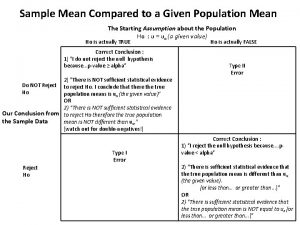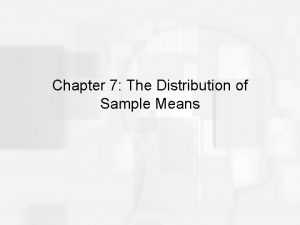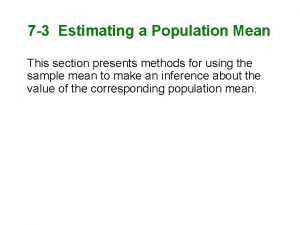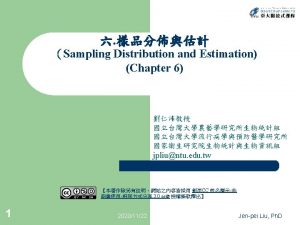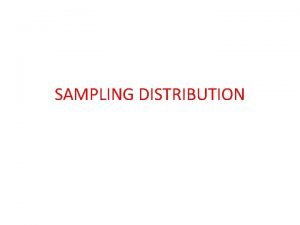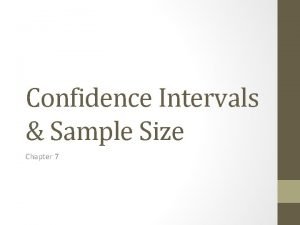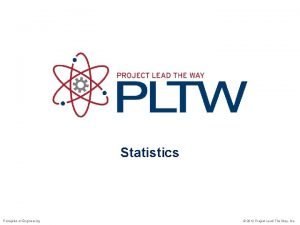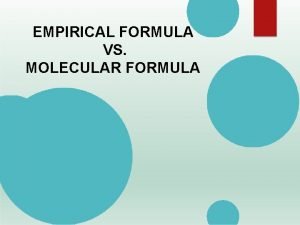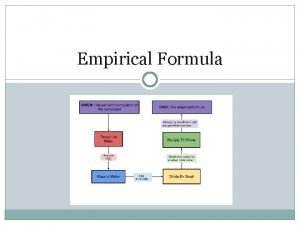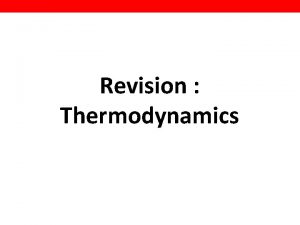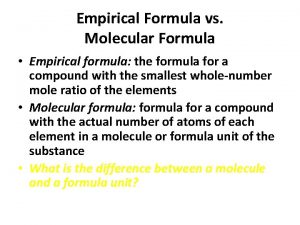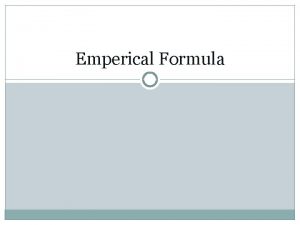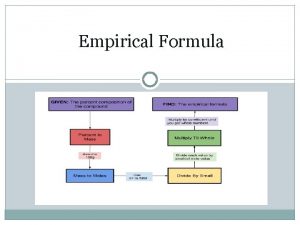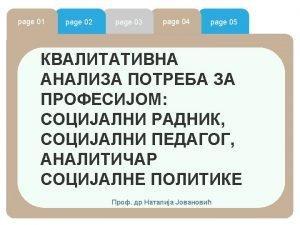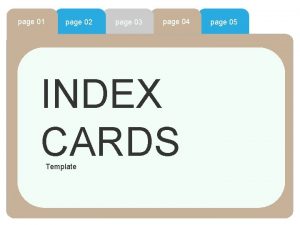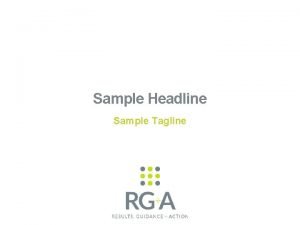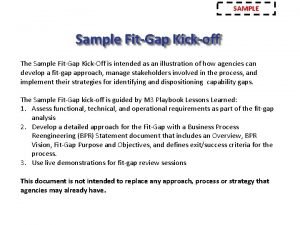Mean A Formula page 6 The Sample Mean












































- Slides: 44

Mean, A Formula: page 6 The Sample Mean. If X is any random variable, then, as n increases without bound, the distribution of its standardized sample mean, approaches the distribution of the standard normal random variable, Z, whose p. d. f. is This is called the Central Limit Theorem. (material continues) T C I

Normal Distributions. Standard Normal Distributions, Standard Normal 1. STANDARD NORMAL(Mean 0 & Standard deviation 1) In The Sample Mean we derived the probability density function for the standard normal random variable Z. We can use integration and f. Z to compute probabilities for Z. Example 1. Compute P( 0. 74 Z 1. 29). As we saw in Integration, To evaluate the integral open Integrating. xls and enter the function as =(1/SQRT(2*PI()))*EXP(-0. 5*x^2). Recall that x is the only variable that can be used in Integrating. xls (material continues) T C I

Normal Distributions. General Normal, General Normal 2. GENERAL NORMAL(Any Mean & Any Standard deviation/But its standardization is a standard normal distribution) The adjective “standard”, used in standard normal distributions, implies that there are “non-standard” normal distributions. This is indeed the case. A random variable, X, is called normal if its standardization, has a standard normal distribution. It can be shown that the probability density function for a normal random variable, X, with mean X and standard deviation X has the following form. (material continues) T C I

Normal Distributions • Standard Normal Random Variable (Z) • p. d. f. • Can use Integrating. xls to find probabilities

Normal Distributions • Ex 1. Find • Soln: show ex 1 excel file

Normal Distributions • Ex. Find a number so that • Soln: show ex 2 excel file .

Normal Distributions • The previous example tells us that 97. 5% of all data for a standard normal random variable lies in the interval. • This means that 2. 5% of the data lies above z = 1. 96 • Graphically, we have the following:

Normal Distributions • The shaded region corresponds to 97. 5% of all possible area (note 2. 5% is not shaded) 1. 96

Normal Distributions • Due to symmetry, we get 95% of the area shaded with 5% not shaded (2. 5% on each side) -1. 96

Normal Distributions • This means that a 95% confidence interval for the standard normal random variable Z is (-1. 96, 1. 96) -1. 96

Normal Distributions • A 95% confidence interval tells you how well a particular value compares to known data or sample data • The interval that is constructed tells you that there is a 95% probability that the interval will contain the mean of X. • Another interpretation is that 95% of all values found in a sample should lie within this 95% confidence interval.

Normal Distributions • Possible formulas: Z Standard Normal random variable

Normal Distributions • Possible formulas:

Important • Possible formulas: If is unknown The sample standard deviation, , will be a very good approximation for

Normal Distributions • Remember, that -1. 96 and 1. 96 were special values that apply to a 95% confidence interval • You need to find different values for other types of confidence intervals. • Ex. Find a 99% confidence interval for Z. Find a 90% confidence interval for Z.

Normal Distributions • Soln: • Ex. What is the confidence interval for Z with 1 standard deviation? 2 standard deviations? 3 standard deviations?

Normal Distributions • Soln:

Normal Distributions • Soln:

Normal Distributions • Since Z is a standard normal random variable, Z would have standardized some variable X. • So,

Normal Distributions • Ex. Suppose X is a normal random variable with and. Find a 95% confidence interval for X if the 95% confidence interval for Z is (-1. 96, 1. 96).

Normal Distributions • Soln: So, the 95% confidence interval for X is (90. 6, 149. 4). We are 95% confident that this interval contains the true mean

Normal Distributions • Ex. Suppose X is a normal random variable. If a sample of size 34 was taken with and , find a 95% confidence interval for the sample mean-remember this is if the 95% confidence interval for Z is (-1. 96, 1. 96).

Normal Distributions • Soln:

Normal Distributions • Soln: So, the 95% confidence interval for is (114. 9579, 125. 0421). We are 95% confident that this interval contains the true mean

Normal Distributions • General Normal Random Variable • p. d. f. • Probabilities are done similarly to Standard NRV

Normal Distributions • Ex. If X is a normal random variable representing exam 1 scores with mean 75 and standard deviation 10, find. • Soln:

Normal Distributions • NORMDIST function in Excel • Can calculate p. d. f. and c. d. f. values for a normal random variable • Ex. If X is a normal random variable representing exam 1 scores with mean 75 and standard deviation 10, find.

Normal Distributions(show excel) • Soln:

Normal Distributions • Specific values for the p. d. f. can also be calculated using NORMDIST • Ex. Find height of p. d. f. of a normal random variable X at X = 90 that has a normal distribution with and.

Normal Distributions • Soln: Two ways to solve=0. 009 (1) Evaluate (2) Evaluate =NORMDIST(90, 71, 12, FALSE) using Excel

Normal Distributions • How does the mean and standard deviation affect the shape of the Normal Random Variable graph? • Ex. Graph the p. d. f. of a normal random variable with the following characteristics: (1) and (2) and (3) and (4) and

Why? Normal Distributions Recall-General Normal random variable p. d. f • Soln: (1) Max Height 0. 40 The y-values of the graph around x = -3 and x = 3 are very small and

Normal Distributions • General Normal Random Variable e^(0)=1 • p. d. f.

Normal Distributions-sec 1 -4/13 Why? • Soln: (2) Max Height (This is 0. 40 and 0. 08 std. dev. ) Y values very small Around x = -15 and x = 15 (This is 3 standard deviations from the mean- )

Normal Distributions • General Normal Random Variable e^(0)=1 • p. d. f.

Normal Distributions • Soln: (3) Max Height (At x = 4) 0. 40 Y values very small around x = 1 and x = 7 (This is 3 standard deviations from the mean) and

Normal Distributions • Soln: (4) Max Height (This is 0. 40 0. 08 std. dev. ) Y values very small around x = -11 and x = 19 (This is 3 standard deviations from the mean) and

Normal Distributions • Ex. Find the mean and standard deviation for the following normal random variables graphed. (A)

Normal Distributions • Mean is 6 and standard deviation is 3

Normal Distributions • (B)

Normal Distributions • Mean is -7 and standard deviation is 2

Normal Distributions • (C)

Normal Distributions • Mean is 300 and standard deviation is 50

Normal Distributions • Relationship between p. d. f. and c. d. f. • • • So,
 Population mean from sample mean
Population mean from sample mean If σm = 4 and n = 36, then σ =:
If σm = 4 and n = 36, then σ =: How to calculate point estimate
How to calculate point estimate Mean of the sampling distribution of the sample mean
Mean of the sampling distribution of the sample mean Mla format title page
Mla format title page Formula for sampling distribution
Formula for sampling distribution Mean formula
Mean formula Sample size
Sample size Population mean
Population mean In text citation with multiple authors
In text citation with multiple authors Proposal cover page
Proposal cover page Hát kết hợp bộ gõ cơ thể
Hát kết hợp bộ gõ cơ thể Frameset trong html5
Frameset trong html5 Bổ thể
Bổ thể Tỉ lệ cơ thể trẻ em
Tỉ lệ cơ thể trẻ em Chó sói
Chó sói Tư thế worm breton là gì
Tư thế worm breton là gì Chúa sống lại
Chúa sống lại Các môn thể thao bắt đầu bằng từ đua
Các môn thể thao bắt đầu bằng từ đua Thế nào là hệ số cao nhất
Thế nào là hệ số cao nhất Các châu lục và đại dương trên thế giới
Các châu lục và đại dương trên thế giới Công của trọng lực
Công của trọng lực Trời xanh đây là của chúng ta thể thơ
Trời xanh đây là của chúng ta thể thơ Mật thư anh em như thể tay chân
Mật thư anh em như thể tay chân 101012 bằng
101012 bằng Phản ứng thế ankan
Phản ứng thế ankan Các châu lục và đại dương trên thế giới
Các châu lục và đại dương trên thế giới Thể thơ truyền thống
Thể thơ truyền thống Quá trình desamine hóa có thể tạo ra
Quá trình desamine hóa có thể tạo ra Một số thể thơ truyền thống
Một số thể thơ truyền thống Cái miệng nó xinh thế chỉ nói điều hay thôi
Cái miệng nó xinh thế chỉ nói điều hay thôi Vẽ hình chiếu vuông góc của vật thể sau
Vẽ hình chiếu vuông góc của vật thể sau Biện pháp chống mỏi cơ
Biện pháp chống mỏi cơ đặc điểm cơ thể của người tối cổ
đặc điểm cơ thể của người tối cổ Thế nào là giọng cùng tên? *
Thế nào là giọng cùng tên? * Vẽ hình chiếu đứng bằng cạnh của vật thể
Vẽ hình chiếu đứng bằng cạnh của vật thể Tia chieu sa te
Tia chieu sa te Thẻ vin
Thẻ vin đại từ thay thế
đại từ thay thế điện thế nghỉ
điện thế nghỉ Tư thế ngồi viết
Tư thế ngồi viết Diễn thế sinh thái là
Diễn thế sinh thái là Dot
Dot Bảng số nguyên tố lớn hơn 1000
Bảng số nguyên tố lớn hơn 1000 Tư thế ngồi viết
Tư thế ngồi viết
